
Wilkinsburg is a borough in Allegheny County, Pennsylvania, United States. The borough has a population of 14,349 as of the 2020 census. Wilkinsburg is part of the Pittsburgh metropolitan area. The borough was named for John Wilkins Jr., a United States Army officer who served as Quartermaster General of the United States Army from 1796 to 1802.
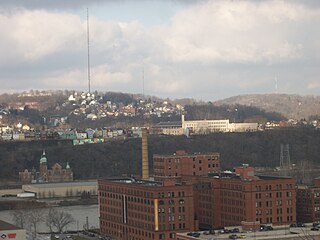
Spring Hill is a neighborhood on Pittsburgh, Pennsylvania's North Side. Spring Hill was named for the abundance of springs near the site. According to a 1977 Neighborhood Atlas, "Germans immigrated there from 1850 to 1920, giving the neighborhood a Bavarian atmosphere. Local street names include Rhine, Woessner, Haslage, Zoller and Goehring. In 1959 ACTION-Housing opened Spring Hill Gardens, a moderate rent, racially integrated, 209-unit apartment project at Buente and Rhine Streets. Spring Hill Gardens was Pittsburgh's first multi-family housing project backed by the Federal Housing Authority."

California-Kirkbride is a neighborhood on Pittsburgh, Pennsylvania's North Side.

Fineview — known to older generations as Nunnery Hill — is a neighborhood on Pittsburgh's North Side with expansive views of downtown Pittsburgh. The most famous of these views is from the Fineview Overlook at the corner of Catoma Street and Meadville Street.
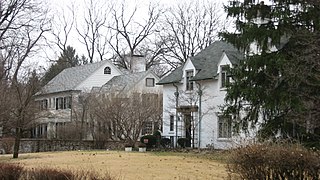
Golden Hill is an affluent and historic neighborhood overlooking the White River on the west side of Indianapolis's Center Township, in Marion County, Indiana. The district is bounded on the east by Clifton Street, which is west of Martin Luther King Jr. Boulevard ; on the west by the White River and the Central Canal; on the south by Thirty-sixth Street; and on the north by Woodstock Country Club, immediately south of Thirty-eighth Street. Golden Hill is noted for its collection of homes designed by several of the city's prominent architects. The estate homes reflect several styles of period revival architecture. The district is known as for its community planning and remains an exclusive enclave for the city's prominent families. Golden Hill was added to the National Register of Historic Places in 1991.
The Pittsburgh History & Landmarks Foundation (PHLF) is a nonprofit organization founded in 1964 to support the preservation of historic buildings and neighborhoods in Pittsburgh, Pennsylvania, USA.

The Lummus Park Historic District or simply Lummus Park, is on the National Register of Historic Places and a locally historic designated district in Miami, Florida. It is roughly bound by Northwest Fifth Street to the north, Flagler Street to the south, Northwest Third Avenue to the east, and the Miami River to the west. On October 25, 2006, it was added to the U.S. National Register of Historic Places. Lummus Park has some of the oldest structures in Miami, and over the decades, has been able to retain a large part of its early pioneer character.

The Pittsburgh City-County Building is the seat of government for the City of Pittsburgh, and houses both Pittsburgh and Allegheny County offices. It is located in Downtown Pittsburgh at 414 Grant Street, Pittsburgh, Pennsylvania. Built from 1915-17 it is the third seat of government of Pittsburgh. Today the building is occupied mostly by Pittsburgh offices with Allegheny County located in adjacent county facilities. It also contains a courtroom used for the Pittsburgh sessions of the Supreme Court of Pennsylvania.

The Riverview Terrace Historic District is a 15.2-acre (6.2 ha) historic district in Davenport, Iowa, United States, that was listed on the National Register of Historic Places in 1984. It was listed on the Davenport Register of Historic Properties in 1993. The neighborhood was originally named Burrow's Bluff and Lookout Park and contains a three-acre park on a large hill.

The Prospect Park Historic District in Davenport, Iowa, United States, is a historic district that was listed on the National Register of Historic Places in 1984. In its 23.2-acre (9.4 ha) area, it included 23 contributing buildings in 1984. The Prospect Park hill was listed on the Davenport Register of Historic Properties in 1993.

The Allegheny City Stables, located at 840 W North Avenue in the Central North Side neighborhood of Pittsburgh, Pennsylvania, was built in 1895.

The Albright United Methodist Church is a disused church building at 486 S. Graham Street at the nexus of the Bloomfield, Shadyside, and Friendship neighborhoods of Pittsburgh, Pennsylvania, US. The church was designed by architect Chancey W. Hodgdon in an Eclectic, Richardson Romanesque style with prominent elements of Gothic Revival, and was built in 1905-1906.
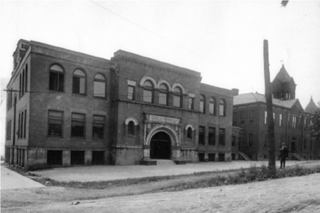
The Spring Hill Elementary School is located at 1351 Damas Street in the Spring Hill neighborhood of Pittsburgh, Pennsylvania. The building was first constructed in 1896 in the Classical Revival style and serves as the elementary school for residents of the Spring Hill area.

The Carol Peterson House is located at 172 46th Street in the Lawrenceville neighborhood of Pittsburgh, Pennsylvania. The house was built in 1886–1887 in the Italianate architectural style, and is named after the architectural historian, Carol Peterson.

Roslyn Place is a collection of houses located at 506-523 & 525 Roslyn Place in the Shadyside neighborhood of Pittsburgh, Pennsylvania. Built between 1914 and 1917 in the Colonial Revival and Georgian Revival architectural styles, the houses currently serve residential functions.
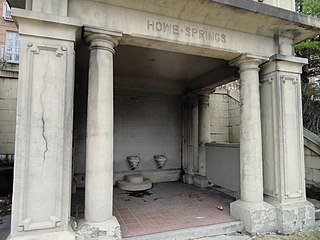
Howe Springs is located on the southern side of Fifth Avenue between South Highland Avenue and College Street in the Shadyside neighborhood of Pittsburgh, Pennsylvania. The spring was originally built in 1896 in the Romanesque architectural style, and was later renovated in 1912 in the neoclassical style.
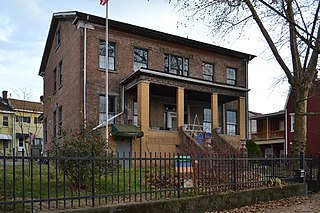
The Mowry-Addison Mansion is a historic house in the Upper Lawrenceville neighborhood of Pittsburgh, Pennsylvania, and a contributing property in the Lawrenceville Historic District. It was built in 1830–32 by Peter Mowry, a physician, and was originally part of a large estate that was subdivided into residential lots in 1872. The house is notable as a rare example of relatively well preserved Greek Revival architecture in Pittsburgh, and exemplifies the typical pattern of development in Lawrenceville in the mid to late 19th century. In 2020, the building was nominated as a Pittsburgh historic landmark by Preservation Pittsburgh, which stated that the mansion "is one of the last remaining and most significantly preserved regional ribbon farm dwellings from its period of construction."

The Shrine of the Blessed Mother, also known as Our Lady of the Parkway and the Queen of Peace, is located at 6 Wakefield Street in the Oakland neighborhood of Pittsburgh, Pennsylvania. The shrine overlooks the Penn-Lincoln Parkway (I-376). Built in the Vernacular style, the shrine historically and currently acts as a place of worship for Catholic worshippers. In March 2020, Preservation Pittsburgh nominated the site for City of Pittsburgh Historic Landmark status. Pittsburgh City Council voted to designate the Shrine of the Blessed Mother as a historic structure on October 6, 2020.

The Herron Hill Pumping Station is located at 4501 Centre Avenue in the North Oakland neighborhood of Pittsburgh, Pennsylvania. Built in the Classical Revival architectural style, the building was instrumental in distributing water throughout Pittsburgh’s East End neighborhoods, such as the Hill District and Squirrel Hill. In May 2020, Preservation Pittsburgh nominated the structure for City of Pittsburgh Historic Landmark status. In July 2020, the City of Pittsburgh's Historic Review Commission determined that the structure's nomination to be a City of Pittsburgh Historic Landmark was viable.

The Columbia Historic District is a neighborhood in Cedarburg, Wisconsin, that is listed on the National Register of Historic Places. At the time the district was listed on the register, its contributing properties included 128 historic homes, one church, and eighty-seven historic outbuildings, including garages and barns, all constructed between 1844 and 1938. The district also contained several dozen buildings that do not contribute to the historic district, including modern homes from the post-war era as well as modern garages and other additions to historic properties.






















